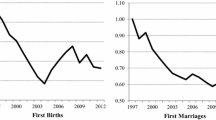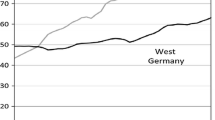Abstract
In this paper we make use of the panel aspects of the German GSOEP, the Swedish HUS and the British BHPS data. In these data sets we known month and year of childbirth and the month to month labor force status of the mother also before giving birth. This permits analysis of labor force transitions triggered by child births of different birth orders. From macro data Swedish women are known to have the highest labor force participation. The difference in total labor force participation of women is totally a result of fewer mothers entering the labor force and entering later in Germany and Great Britain than in Sweden. This paper shows that before birth of first child there is no such difference. We find that German and British women have even higher full-time labor force participation than Swedish women 12 months before the birth of the first child. The difference is more pronounced for second and third births than for first births. We suggest that these differences are caused by different family policy regimes where Germany can be characterized as a breadwinner regime and Sweden a regime oriented towards equal role sharing of father and mother. Our results on determinants of being in the labor force both after and before the birth of a child as well as determinants of the tempo of entering the labor force after birth shows that women's own human capital is important both in Germany and Great Britain, whereas in Sweden also less educated women have entered the labor force by the time the child is 2 years old.
Similar content being viewed by others
References
Aronsson T, Walker J (1995) The effects of Sweden's welfare state on labor supply incentives, SNS Occasional paper no. 64, January 1995, Stockholm
Blundell R (1993) Taxation and labour supply: Incentives in the UK. In: Atkinson A, Mogensen V (eds) Welfare and work incentives. Clarendon Press, Oxford, 135–160
Brown J, Small S (1991) Maternity benefits. The Public Policy Institute, London
Bundesministerium fur Arbeit and Sozialordnung (1991) Übersicht über die Soziale Sicherheit
Cohen B, Clarke K (1986) Child care and equal opportunities. HMSO, London
Cohen B (1988) Caring for children: services and policies for child care and equal opportunities in the UK. Report for the European Commission's Child Care Network, Family Policies Centre, London
Cohen B (1990) Caring for children. The 1990 report. Report for the European Commission's Child Care Network, Family Policies Centre, London
Corti L, Laurie H, Dex S (1994) Caring and employment. Employment Department Research Series No. 39
Dale A, Joshi H (1992) The economic and social status of British women. In: Butler G, Heilig G, Schmitt-Rink G (eds) Acta demographica. Physica Verlag, Heidelberg, 27–46
Daniel WW (1980) Maternity rights: The experience of women. Policy Studies Institute, London
Dex S (1984) Women's work histories: An analysis of the women and employment survey. Research Paper No. 46, Department of Employment, London
Dex S (1987) Women's occupational mobility. Macmillan, London
Dex S (1991) The reliability of recall data: A literature review. Working Paper 11 of the ESRC, Research Centre on Micro-social change in Britain, University of Essex, Colchester
Dex S, Walters P, Arden M (1993) French and British mothers at work. Macmillan, London
Esping-Andersen G (1990) The three worlds of Welfare Capitalism. Princeton University Press, Princeton
Gregg P, Wadsworth J (1995) More work in fewer households? Discussion paper 72, National Institute of Economic and Social Research
Gustafsson B, Klevmarken AN (1993) Taxes and transfers in Sweden: Incentice effects on labour supply. In: Atkinson A, Mogensen V (eds) Welfare and work incentives. Clarendon Press, Oxford, 50–134
Gustafsson SS (1984) Equal opportunity policies in Sweden. In: Schmid G, Weitzel R (eds) Sex discrimination and equal opportunity. The labour market and employment policy. Wissenschaftszentrum, Berlin and Gower, London, 132–154
Gustafsson SS (1992) Separate taxation and married women's labor supply, a comparison of West Germany and Sweden. Journal of Population Economics 5:61–85
Gustafsson SS (1992) Cohort size and female labour supply. European Journal of Population 8:1–21
Gustafsson SS (1994) Child care and types of welfare states. In: Sainsbury D (ed) Gendering welfare states. Sage, London, 45–61
Gustafsson SS, Bruyn-Hundt M (1991) Incentives for women to work: A comparison between The Netherlands, Sweden and West Germany. Journal of Economic Studies 18:30–66
Gustafsson SS, Stafford F (1992) Child care subsidies and labor supply in Sweden. Journal of Human Resources 27:204–230
Gustafsson SS, Stafford F (1994) Three regimes of child care. In: Blank R (ed) Social protection versus economic flexibility: Is there a tradeoff? National Bureau of Economic Research and University of Chicago Press, Chicago, 333–361
Gustafsson SS, Stafford F (1995) Equity and efficiency trade-offs in early childhood care and education. 1996 forthcoming in Barnett S, Boocock S (eds) Early childhood care and education for disadvantaged children: Long term effects. SUNY Press, New York
Hoem JM (1993) “Public policy as the fuel of fertility: effects of a policy reform on the pace of childbearing in Sweden in the 1980s”. Acta Sociologica 36:19–31
Jenkins SP (1994) Winners and losers: A portrait of the UK income distribution during the 1980's. Discussion paper 94–107, Department of Economics, University College Wales, Swansea
Joshi H, Hinde PRA (1993) Employment after childbearing in post-war Britain: Cohort study evidence on contrasts within and across generations. European Sociological Review 9:203–227
Joshi H, Macran S, Dex S (1995) Employment, childbearing and women's subsequent labor force participation: evidence from the British 1958 birth cohort. Mimeo, City University, London. A Survival Analysis, NCDS working paper 40
Klevmarken A, Olovsson P (1993) Household market and nonmarket activities: procedures and codes 1994–1991. Almqvist & Wiksell International, Stockholm
Leibowitz A, Klerman JA, Waite LJ (1992) Employment of new mothers and child care choice. Journal of Human Resources 27:112–133
McRae S (1991) Maternity rights in Britain. Policy Studies Institute, London
Macran S, Joshi H, Dex S (1995) Employment after childbearing: A survival analysis. Work Employment and Society (forthcoming)
Martin J, Roberts C (1984) Women and Employment: A life-time perspective. Department of Employment/OPCS. HMSO, London
Moss P (1988) Child care and equality of opportunity. Consolidated Report to the European Commission, EEC Report V/746/88-EN
Moss P (1990) Child care in the European Community 1985–1990. Women in Europe, Supplements No. 31, Raben and Sjögren Publishers
Myrdal A, Myrdal G (1934) Kris i befolkningsfröagan. Stockholm
Nelson JA (1991) Tax reform and feminist theory in the United States: Incorporating human connection. Journal of Economic Studies 18:11–30
OECD (1990) Employment outlook. OECD, Paris
Ondrich J, Spiess K, Yang Q (1996) Barefoot and in a German kitchen: Federal parental leave and benefit policy and the return to work after childbirth in Germany. Journal of Population Economics 9:247–266
Ostner I (1993) Slow motion: Women, work and the family in Germany. In: Lewis J (ed) Women and social policy in Europe. Edward Elgar Aldershot, England, 92–115
Rönsen M, Sundström M (1996) Maternal employment in Scandinavia. A comparison of the after-birth employment activity of Norwegian and Swedish women. Journal of Population Economics 9:267–285
Sainsbury D (1994) Gendering welfare states. Sage, London
Sainsbury D (1996) Gender, equality and welfare states. Cambridge University Press, Cambridge (forthcoming)
Socialstyrelsen (1995) Barnomsorgen 1994. Socialtjänst 1995 no. 9, Stockholm
Statistics Sweden (1989) SCB Befolkningsstatistik. Barnomsorgundersokningen 1989, SM:S 8901, Stockholm
Statistics Sweden (I992) SCB Befolkningsstatistik del 4, Stockholm
Sundström M, Stafford F (1992) Parental leaves? Female labor force participation and public policy in Sweden. European Journal of Population 8:199–215
Taylor M (ed, 1992) British household panel survey user manual, Volumes A and B. Essex University ESRC Research Centre on Micro-Social change
Vermeulen H, Dex S, Callan T, Dankmeyer B, Gustafsson S, Lausten M, Smith N, Schmauss G, Vlasblom JD (1995) Tax systems and married women's labour force participation: A seven country comparison. Working Papers of the ESRC Research Centre for Micro-Social Change. Paper 95-8. Colchester: University of Essex. Labour force Network
Wagner GG, Schupp J, Rendtel U (1991) The socio-economic panel of Germany. Methods of production and management of longitudinal data. DIW discussion Paper 31a, Berlin
Zimmermann KF (1993) Responses to taxes and benefits in Germany. In: Atkinson AB, Mogensen GV (eds) Welfare and work incentives. A North European Perspective. Clarendon Press, Oxford, 192–240
Author information
Authors and Affiliations
Additional information
All correspondence to Cécile Wetzels. We are grateful to Andrew McCulloch from ESRC Research Centre on Micro-Social Change in Britain, who delivered the British BHPS-data. We also want to thank John F. Ermisch, Siv Gustafsson, Diane Sainsbury and two anonymous referees for useful comments. Financial support has been received by the Swedish Council in the Humanities and Social Sciences and the EU Human Capital and Mobility (HCM) network for the Female Labour Force Participation Network within which framework this analysis has been carried out. Responsible editors: S. S. Gustafsson, John R Ermisch.
Rights and permissions
About this article
Cite this article
Gustafsson, S.S., Wetzels, C.M.M.P., Vlasblom, J.D. et al. Women's labor force transitions in connection with childbirth: A panel data comparison between Germany, Sweden and Great Britain. J Popul Econ 9, 223–246 (1996). https://doi.org/10.1007/BF00176686
Received:
Accepted:
Issue Date:
DOI: https://doi.org/10.1007/BF00176686




